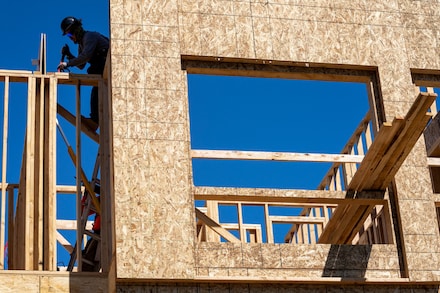Construction dips in cities and suburbs. Rural regions see boost.
After posting strong growth last year, single-family construction continued falling in nearly every U.S. region over the second quarter this year, but some rural residential markets are bucking that trend.
Large metropolitan and suburban regions reported a sizeable 3.8% dip in single-family construction, according to the National Association of Home Builders Home Building Geography Index, released Tuesday.
“Single-family production continues to lag behind last year’s levels due to housing affordability challenges, including persistently high mortgage rates, the skilled labor shortage and excessive regulatory costs,” NAHB Chairman Buddy Hughes said in a statement. “Policymakers at all levels of government need to improve the business climate so that builders can build more homes by eliminating unnecessary regulations, promoting careers in the skilled trades and overturning inefficient zoning rules.”
One exception to the second quarter’s declining single-family construction? Rural microcounties, NAHB found. Microcounties reported a 1.8% rise, “marking the fifth straight quarter of construction growth in these counties,” the organization said.
According to the Census Bureau, a microcounty, or micropolitan statistical area, is a small urban region that includes:
- One or more counties centered on a town or city with 10,000 to 50,000 people.
- Nearby counties that are closely connected to that town or city — mainly because many people commute there for work, shopping, or other daily activities.
Less densely populated areas, overall, hold 50.2% of the country’s single-family market share — the largest since early 2023.
Number of construction workers quitting jobs nose-dives in July
Amid pressure from immigration crackdowns, the U.S. construction industry saw a spike in job openings in July, but the number of construction workers quitting plunged.
The number of construction job openings (306,000) at the end of July reflected a high of more than 12 months, according to an Associated Builders and Contractors' analysis of the U.S. Bureau of Labor Statistics’ Job Openings and Labor Turnover Survey. Those postings represented a 64,000 increase from June and a 77,000 rise from July 2024.
“The construction job opening rate rose to the highest level in over a year during July,” said ABC chief economist Anirban Basu. “Given the ongoing decline in nonresidential construction spending, however, that increase is likely attributable to immigration policy and its effects on the industry’s labor force rather than any increases in the demand for construction workers.”
But fewer workers are quitting; that rate dove from 1.9% in June to 0.9% in July, Basu explained. “Fewer construction workers quit their jobs in July than in any month over the past nine years, suggesting widespread concern about job security, while layoffs jumped to the highest level since [the first quarter] of 2023.”
That said, data from the job openings survey "can be volatile from month to month, and it’s difficult to know the degree to which undocumented workers are or are not captured in the data,” Basu said. “More than 55% of ABC members expect to increase their staffing levels over the next six months, according to the July reading of the Construction Confidence Index. That measure will be critical to monitor in the months ahead.”
As smart home devices advance, young owners will hire installers, study says
As the market for smart home devices, including lighting and internet-connected thermostats, strengthens in the United States, households will need professional help installing the new technology, a survey suggests.
The smart home market could hit $15 billion in revenue over the next four years, according to the author of the study, research firm Parks Associates, which expects demand for professional services related to the devices to strengthen in kind. The Dallas-based organization polled 8,000 internet-using households across the country, finding that, even if users attempt to install a smart home device on their own, 29% ultimately call in professional help.
Overall, 44% of the users surveyed hired a professional to install at least one smart home device, and 81% tried to themselves. But Parks Associates found a generational divide: Younger smart home device buyers are “twice as likely to struggle with physical installation versus the general population (42% vs. 19%), suggesting pro-install or ‘do-it-with-me’ approaches are key to serving this demographic.”


